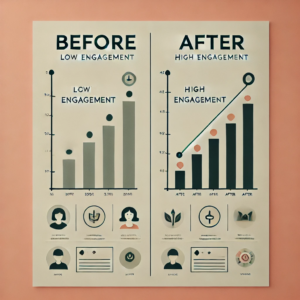Among the many tips for creating engaging content is to balance showing your personality and expertise with your readers’ interests.

Does that mean you’re not just a writer, but a performer? Yes, because quality content doesn’t just inform — it persuades and entertains.
Present your information in a way that keeps readers hooked. As the curtain rises, choose words that reflect your branding and speak to your readers; knowing who you are enhances your authenticity and relatability.
Write with style: add facts to stories or humor or rhyme to make readers smile and key points stick.
So, before you grab the top hat and cane, consider:
- How will I warm up the crowd?
- How will I take the stage on the page?
Based on marketing, audience, and behavioral psychology research, here’s how to create engaging content.
How to Make Your Content More Engaging
1. Address your audience – Google/Greenberg research shows six in ten people expect brands to personalize their experiences based on their preferences.
Picture your reader struggling with a problem. How do they feel? What’s their next step? Show the solutions.
Research your audience and their interests:
- Internally: Which topics and writing styles keep them engaged?
- Externally: Where do they spend time? What do they “like,” comment on, or share?
The answers clue you in to how they think and feel — the core parts of building a connection with them.
It’s part of that buzzword “personalization”: writing to your reader (even if you don’t call them “Jane” or “John,” but “you”).
Detailed personas aren’t always necessary, either. But they can guide you to find wording your readers will respond to. A call to action then sparks the conversation.
2. Show, don’t tell – Studies show storytelling increases trust and empathy and makes information 22 times more memorable. It can also shape how your audience feels about your brand, stirring their emotions enough to inspire them to act.
Bring ideas to life through vivid details:
- Share anecdotes that showcase your expertise.
- Move your audience through making them the hero of your story. Show how you guide them to overcome challenges via relatable characters, conflicts, and resolution.
- Use examples, especially to simplify complex concepts.
- Ask your customers to share their stories, testimonials, or visuals about how your product or service helped them.
- Social proof: use real numbers to reveal how many people bought, subscribed, or asked — preferably those that support your statements. If you can’t show specifics, phrases like “our most popular widget” can still boost your credibility.
Examples are one of my favorite ways to show concepts. I’m still refining my “story-sharing” style. Like others, I’ve mistakenly cast myself as the star in my readers’ story. Depending on the topic, story-sharing comes more naturally to me in personal writing than for business.
David Deutsch’s approach looks at ways to bring people into your copy and share their stories, which eases the process.
You don’t have to follow the crowd. If “story-sharing” isn’t one of your strengths, consider other methods that play to them and distinguish you yet suit your brand like:
🔹 Case studies. Let data and results speak for you.
🔹 Sharing before-and-after transformations.
🔹 Using analogies and metaphors to explain complex ideas.
The key is to “show,” not “tell” in a way that fits you and your brand.

3. Use images strategically – A Skyword study found that content with relevant visuals attracts nearly ten times more views than content without them.
Add a chart that shows your results, like a before-and-after comparison. A compelling infographic or a behind-the-scenes video can also enliven a dry topic.
More examples:
- Videos
- Memes
- Photos or illustrations
Photos and video are reportedly the most effective, especially images that don’t look staged or reinforce clichés (unless you’re making a statement).
Example: The Touristy newsletter mixes snarky takes on current news with fun memes and animations.
Your results might vary — and algorithms could skew them — but in my experience, organic social media posts with relevant images gain more interest. (I don’t scale them to each platform’s recommended sizes.)
Video offers a more in-depth view, bringing the faces behind the screen into the spotlight.
As the saying goes, “a picture is worth a thousand words.” And a well-placed visual can be worth a thousand clicks.
4. Make your content useful – Content Marketing Institute research shows practical, actionable content boosts trust and engagement.
- Guide readers with step-by-step instructions to solve their problem (through words or imagery)
- Provide relevant tips, tools, or templates to help them take the next step
- Add something unique like an insight you gleaned from your experience, even if it goes against the grain
5. Be consistent – Forbes reports that one of their clients who posted blogs every Thursday over six months saw new visits rise nine-fold.
Consistency can also mean using a familiar format (like this listicle) or keeping an idea file for inspiration and motivation.
Time your posts to the ideals for each platform:
- Social media: daily or every few days
- Blogs or newsletters: weekly, biweekly, or monthly; quarterly can be more forgettable, which is why in our age of disposability, print editions stand out
Think of your writing as a performance — one that keeps your readers on the edge of their seats. Stick with it and they’ll return for an encore.
Learn how to create content that connects with clients who value and respect you and your business
Which of these tips for creating engaging content will you use in your next piece? Share your thoughts — or your most engaging stories — in the comments!
Quotes
“Make it simple. Make it memorable. Make it inviting to look at. Make it fun to read.” ~ Leo Burnett
“Your content is not about you; it’s about your audience.” ~ Dan Knowlton
